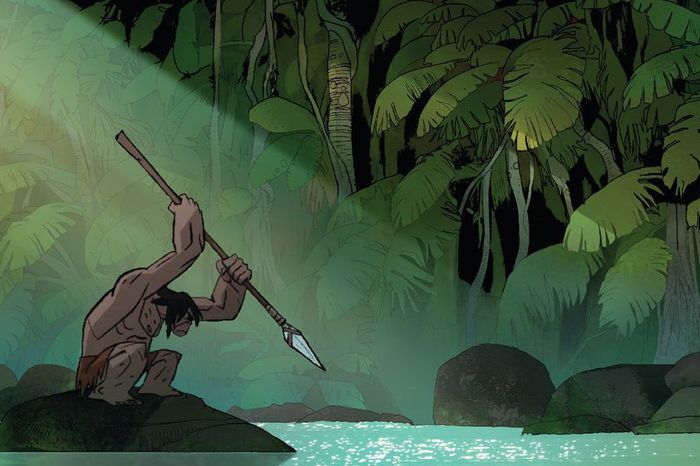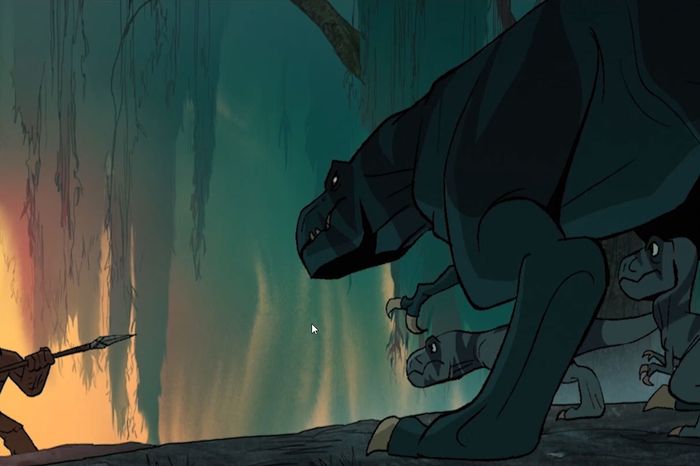
Genndy Tartakovsky is responsible for modern television’s boldest animation, including Dexter’s Laboratory, Star Wars: Clone Wars, and Samurai Jack, as well as the Hotel Transylvania film series. The final season of Samurai Jack, which aired in 2017, represented a remarkable evolution in Tartakovsky’s work: The fight scenes proved to be audacious experiments in mood, color, and sound, putting the stylings of recent big-screen action flicks to shame. It was more violent, more cutting, more mature than the series that came before it, not only visually but narratively and thematically.
Tartakovsky’s new miniseries Primal, which premieres tonight on Adult Swim, is his most ambitious work yet. It’s predicated on a striking gambit: absolutely no dialogue. The fledgling series follows a caveman in primordial times who loses his family in a vicious attack and bonds with a dinosaur also beset by tragedy. Primal boasts a gnarly, pulp sensibility. Its violence is sudden and evocative. Visually, it is both gritty and lush — marrying a sketched aesthetic with a daring color palette full of crimson, jungle green, and inky black. But most important, the show proves to be endlessly thrilling. Ahead of Primal’s debut, I spoke to Tartakovsky about his influences, the art of pitching, and establishing the look of this bold world.
What was the genesis of Primal?
Six or eight years ago, I started doodling this caveman kid with big hair and a dinosaur friend and they have adventures in this weird world. It was going to be a show [for kids ages 6 to 11], but the story wasn’t coming together. Everything I develop has to be organic. If a story isn’t working, maybe that story doesn’t want to be told.
Then through the years, my tastes started to get a little older and adult cartoons started to come into popularity much more. And then came the last season of Samurai Jack. When we were doing that for Adult Swim, it was like, “Oh, my gosh we can do violence. We can tell more sophisticated stories. We can get more emotional, darker.” Thankfully that was met with a lot of success and we had a really fun time doing it. Basically, my boss at the time, Mike Lazzo, was like, “What’s next?” [Laughs.] In that time I have been developing Primal as a short film, so I pitched it to him. I said, “It’s a caveman and a dinosaur. They have a tragedy, they bond, and try to survive this primordial world. There’s no dialogue.” That was our launching point.
It’s very audacious to do a show with no dialogue. Can you talk about your decision to use only sound and imagery to tell your story?
It was because it was a caveman. It made that decision simple. We messed around with it a little bit in the beginning. Should he grunt? Should he have a few words? It is very, very easy to become cheesy.
I can see that.
Because this type of thing has been done. It’s science fiction. It’s pulp. It’s very easy to become cheesy. [Mimics caveman noises, then laughs.] You start to laugh at it, rather than be drawn in by it. So I was like, “We can have him scream, we can have him grunt. But not grunt to talk.” I think we can get away with communicating everything through our drawings.
What is your process like? Do you see sequences in your head, then write a script to justify those action sequences?
Usually, I picture some kind of vignette in my brain. Even when I write scripts, I visualize it first. I see it storyboarded in my head, then I’ll try to write to describe it with words. From day one, as soon as I started drawing, that’s how it’s been. It used to be frustrating because I would see something, but I wasn’t able to draw it. That translation is definitely getting better.
The process is: We think of an idea, an image, or sometimes just a feeling. I want to watch this episode and get this feeling from it. What elements do I need for this to happen? So the stories get really complex, but we know our limitations and we know the tools we have to use. Luckily, even from the days of Dexter, we always tried to approach it from a visual, iconic sense. We’re just getting better at it now.
How do you find the right pacing and tenor for your action sequences?
I always pitch. Early in my career, I realized when you’re pitching something to a group of people, if you get stuck somewhere or something feels unnatural, it’s wrong. A lot of the time I would just skip over it like, “Oh, it’ll be fine when I execute it.” But I was wrong. Everything is about the pitch and the storytelling, just like when you’re telling a story to your friends.
I believe action is very musical. There’s got to be ups and downs, there’s got to be slow parts and fast parts. I let the pitching guide it. For this show, I wanted everything to resonate, so if we’re holding on something, we give it twice as much time as we would before. Because the sound really fills it in, especially with the music, it’s okay to hold onto something for a long time.
Are you influenced by film noir lighting techniques?
Yeah, absolutely. The noir lighting is some of the best and most interesting because they don’t have color. They have black and white, so they make very graphic compositions in [movies] like The Third Man. We studied all that stuff tremendously. But because ours is graphic composition, it gets heightened. Noir is definitely a big inspiration.
Do you draw any influences from silent cinema?
Not so much. I was a big Buster Keaton fan, I like Charlie Chaplin to a degree, but no, that isn’t where this stuff is coming from. This is my love of Sergio Leone films, from the pulp books like Robert E. Howard’s Conan novels and Solomon Kane.
Loneliness was a big theme in Samurai Jack. In Primal, the lead character loses his family in a brutal dinosaur attack. Is loneliness something you consciously want to explore in this story as well? If not, what themes did you have in mind?
I wanted everything to relate back to the title. I wanted things in their most simplistic and raw form. You look at their normal way of survival — sleep, eat, hunt — and then you have this juxtaposition of these two characters having to survive together. They’re equal in a way. They’re both kind of beasts. We could have easily gone with a man and dog [vibe], where Fang has to listen to him all the time. It didn’t feel right. This is a more interesting relationship.
How did you establish the look of Primal’s world? It’s very different from Samurai Jack.
Our number-one goal was grittiness. We wanted things to be very drawn, very detailed. We didn’t want to just repeat Samurai Jack. There’s still a sensibility we’ll never get around — and it will hopefully all feel like our work — but we are trying to push ourselves to do something different. With this, we love the grittiness of illustrations from Frank Frazetta. We wanted to do something that iconic.
Christian Schellewald, who does all our background drawings, he draws a very illustrative, almost Mobius kind of style. Scott Wills, who has been my production designer Samurai Jack and Clone Wars, he has a very unique color sensibility that’s his own. Whenever you find people like that, you just want to grab onto them and hold on for dear life because they’re going to elevate your work to more than you can imagine it to be. I’m a fan of Astro Boy and thought, “I can draw this manly, Astro Boy–type style.” As the world started to come together from Christian’s drawings to Scott’s color, I was like, “This guy doesn’t fit. He needs to be more mature, more bold, more gritty.”
What do you hope audiences take away from their journey with Primal?
Fun. [Laughs.] Brutality. Something different than they’ve experienced before. Especially in today’s landscape where there’s so much programming, how do you stand out? How do you get people to tune in? You give them something different.




